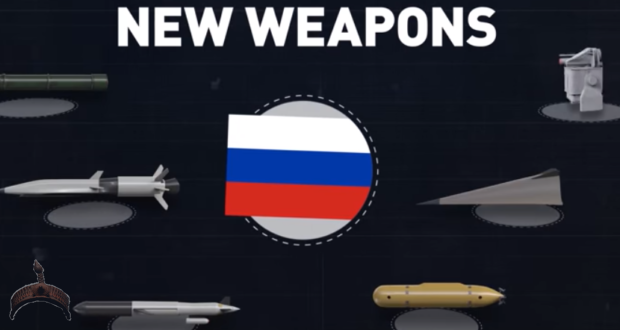It would not be an exaggeration to say that the March 1st, 2018, speech of President Putin to the Federal Assembly, had a tectonic effect on the world public opinion. Initially, some tried to dismiss it as “Russian propaganda” and “bad CGI”, but pretty soon the reality hit hard, very hard: the Russians either had already deployed or were about to deploy weapon systems which were decades ahead of anything similar in the West and against which the West had no defensive measures.
For those interested in a good summary about these weapons, please check this rather well done RT video:
Testifying before the Senate Armed Services Committee, Air Force Gen. John Hyten, bluntly speaking of hypersonic weapons declared under oath that:
“Our defense is our deterrent capability. We don’t have any defense that could deny the employment of such a weapon against us, so our response would be our deterrent force, which would be the triad and the nuclear capabilities that we have to respond to such a threat.”
In plain English this means the following: there are only two ways to deter an attack – denial or punishment. Denial is when you prevent your adversary from striking you; punishment is when you make him pay dearly for the price of this attack. Punishment is a very tricky and undesirable situation, not only because it gives “escalation dominance” to the other side, but also because using nuclear capabilities against a peer or even higher than peer nuclear superpower like Russia basically entails collective suicide. Think of this in simple, practical terms. Say Russia disables or even sinks a US Navy carrier with a couple of hypersonic missiles. What would you do as a US President? The Russian Navy simply does not have as lucrative (and highly symbolic) target as a US aircraft carrier anyway, but even if you decided to strike at the Admiral Kuznetsov or the heavy nuclear missile cruiser Petr Velikii, would you risk using nukes even though the Russians might reply in kind? There is currently no US cruise missile capable of hitting, nevermind sinking, either the Kuznetsov or the Petr Velikii (who both have advanced air defenses which can easily defeat even a swarm of subsonic US anti-ship missiles, especially if they are escorted, which they will be).
The bottom line is this: the recent Russian advances in missile technology have basically made the US surface fleet pretty much useless in a conflict against Russia (and probably against China too). At the same time, Russian advances in air defenses have not only made the entire US ABM system basically useless, it also denies the USA the cornerstone of all its tactics: air superiority. This reality is slowly but surely sinking in. This means that many billions of US tax dollars have gone to waste. Not only that, but the entire US military strategy is now obsolete.
But there is more bad news for the AngloZionist Empire: in a recent interview by General Iurii Borisov, Deputy Prime Minister for Defense and Space Industry named six weapons systems which, in his opinion, have no counterpart in western arsenals. These include two almost never (or very rarely) mentioned before:
- The “Sarmat” heavy MIRVed ICBM
- The Sukhoi Su-57 aka “PAKFA”, the 5th generation jet fighter being developed for air superiority and attack operations
- The revolutionary T-14 “Armata” main battle tank
- The long-range S-500 air defense system
- The mobile anti-satellite system “Nudol“
- The ground-based mobile jamming system for satellite communications “Triada-2S“
While the first four systems listed have been known for a while, very little is known about the Nudol ASAT or the Triada-2S jamming systems. A couple of years ago, in 2015, The Washington Free Beacon wrote one article about the Nudol system entitled “Russia Flight Tests Anti-Satellite Missile Moscow joins China in space warfare buildup” but I did not find anything at all in English about the Triada-2S. There are a few articles published about these two systems in Russian however, and I will summarize them here beginning with the Nudol system
The Nudol weapons system
Artists’ representation of the Nudol weapons system
One Russian blogger posted what he says was a drawing of the Nudol system taken from an internal calendar of the Almaz-Antey Corporation. This is what Nudol is supposed to look like (see image). While still interesting, this image really reveals very little about Nudol. A transporter erector launcher (TEL) and two missile containers, just like in the S-300V, not much to go on. A Russian source identifies Nudol as part of a much larger system code-named “A-235/RTTs-181M/OKR Samolet-M” which is formed by integrating three separate systems, a long-range, intermediate range, and a short range. If true, this would indicate that while the Nudol missile launcher is mobile, it would probably have a targeting datalink from both mobile and fixed Russian air defense radars. In fact, the same source confirms that these systems will be fully integrated into the massive Don-2M (and, probably, the Voronezh and Darial) early warning radars. It appears that the Russians had been working on initial concepts for such a weapon system since the 1990s and that 30 years later, this system is still in development. However, some parts of it, such as the Nudol itself, seems to be near completion. It is also interesting to note here that the S-500 “Prometheus” system also mentioned by General Borisov, which is supposed to replace both the S-300s and the S-400s in the Russian armed forces also reportedly has (low-orbit) anti-satellite capabilities (along with anti-ballistic and anti-aircraft missile capabilities). While the specifics are still unclear, what appears to be happening is that the Russians have decided to build a multi-layered but fully integrated air defense, anti-ballistic and anti-satellite system and now that the USA has fully withdrawn from the ABM Treaty, they are preparing to deploy it in the ABM and ASAT segments in the next couple of years.
The Triada-2S system
It appears that, again, we are not dealing with one system here, but two: the mobile anti-satellite complex Rudolf and the mobile complex of radio electronic destruction of communication satellites Triada-2S. Russian sources refer to Rudolf as a mobile “strike” system implying the physical destruction of the targeted satellite while the Triada-2s appears to be destroying the satellite’s electronic communications (called “electronic suppression” in Russian terminology). Just as in the case of the Nudol, these systems appear to still be in the development phase and have not been accepted for deployment yet. It is worth mentioning here that the late Soviet Union had already developed some anti-satellite capabilities, including the ASAT rocket 79М6 (fired from a MiG-21D interceptor) and the Rokot/Nariad-V land-based rocket/missile system. This is all highly classified stuff and the specifics remain unclear, but the fact that work is continuing on these systems and that General Borisov has decided to publicly mention these systems indicate that the Russians are making a determined effort to develop a robust anti-satellite capability.
Continue reading after the page break
 Ọmọ Oòduà Naija Gist | News From Nigeria | Entertainment gist Nigeria|Networking|News.. Visit for Nigeria breaking news , Nigerian Movies , Naija music , Jobs In Nigeria , Naija News , Nollywood, Gist and more
Ọmọ Oòduà Naija Gist | News From Nigeria | Entertainment gist Nigeria|Networking|News.. Visit for Nigeria breaking news , Nigerian Movies , Naija music , Jobs In Nigeria , Naija News , Nollywood, Gist and more









